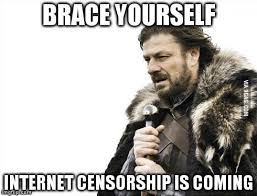QAnon Conspiracy Theorists Can’t Force YouTube to Carry Their Videos–Doe v. Google
This lawsuit is peak 2020. The plaintiffs dubiously characterized themselves as “‘extremely controversial’ ‘conservative news’ channels,” and they claim YouTube tossed them overboard due to its alleged anti-conservative bias. I don’t know the word “conservative” means in the Trump era, but the plaintiffs in this case weren’t mainstream “conservatives” at all. Instead, many or all of them were espousing QAnon conspiracy theories. YouTube wisely decided to crack down on QAnon content, which apparently ensnared the plaintiffs’ videos. So the plaintiffs are now suing to force YouTube to publish QAnon conspiracy videos it doesn’t want to publish. Fortunately, the judge denied the TRO request.
The plaintiffs cherry-picked parts of YouTube’s disclosures to suggest that YouTube had voluntarily limited its right to remove unwanted content from its service. After “reviewing YouTube’s TOS agreement in totality,” the court disagrees. The court cites YouTube’s provision saying “If we reasonably believe that any Content is in breach of this Agreement or may cause harm to YouTube, our users, or third parties, we may remove or take down that Content in our discretion.” Cites to Lewis v. Google and Mishiyev v. Alphabet. The complaint also alleged that YouTube had promised to provide explanations for removals, but the complaint itself referenced YouTube’s explanations. Oops. Thus, the court saw no likelihood of success on the merits, leading to an easy TRO denial.

This isn’t the first time unpopular entities have sued to impose must-carry obligations on Internet companies (e.g., FAN and Fyk; see also Maffick). I’m always curious about the lawyers willing to represent such unpopular clients. In this case, the plaintiffs’ lead lawyers are Cris Armenta and Credence Sol–the same team that represented the plaintiff in Garcia v. Google. As you surely recall, Garcia sued because YouTube didn’t remove a video that was causing her to get death threats. The Ninth Circuit spectacularly rejected the lawsuit as blatantly censorial. But get this: in the Garcia case, the plaintiffs’ lawyers sought to hold YouTube liable for not removing a video that was putting the plaintiff in physical danger; while in this case, the same plaintiffs’ lawyers are trying to force YouTube to keep publishing videos that YouTube thinks are putting people in physical danger. SMDH.
Case citation: Doe v. Google LLC, 2020 WL 6460548 (N.D. Cal. Nov. 3, 2020). The complaint.
Pingback: News of the Week; November 11, 2020 – Communications Law at Allard Hall()